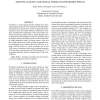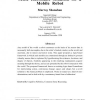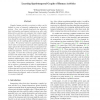76 search results - page 8 / 16 » Modeling and recognition of actions through motor primitives |
COMPUTER
2007
13 years 8 months ago
2007
and therefore should be implemented outside the sensory-motor system. This way, meaning for a concept amounts to the content of a symbolic expression, a definition of the concept ...
ATAL
2007
Springer
14 years 2 months ago
2007
Springer
Recognizing and annotating the occurrence of team actions in observations of embodied agents has applications in surveillance and in training of military or sport teams. We descri...
ICASSP
2011
IEEE
13 years 9 days ago
2011
IEEE
Dysarthria is a motor speech disorder resulting from neurological damage to the part of the brain that controls the physical production of speech and is, in part, characterized by...
ETAI
1998
13 years 8 months ago
1998
Any model of the world a robot constructs on the basis of its sensor data is necessarily both incomplete, due to the robot’s limited window on the world, and uncertain, due to s...
ICCV
2011
IEEE
12 years 8 months ago
2011
IEEE
Complex human activities occurring in videos can be defined in terms of temporal configurations of primitive actions. Prior work typically hand-picks the primitives, their total...



